Onychomycosis - nail damage with a fungal infection. The disease occurs in 5-10% of the population and among other nail lesions is about 30%.
Causes of onychomycosis
Foot nail plate infection occurs mainly in public baths, saunas, pools. Pathogenic fungal scales, which fall into patients with onycomycosis, fall on the floors, benches, bars, trails, carpets and debris. In high humidity conditions, fungi can not only continue for a long time, but also multiply, especially in unpainted wooden benches and grating, which makes them an intense source of infection.

Often, onychomycosis is transmitted within the family when using general shoes, towels, washing clothes, insufficient bathing processing after washing, as well as due to carpets and gradations in the bathroom. Hand nail damage usually occurs when combing skin focuses.
The appearance of onycomycosis is facilitated by nail trauma, especially multiple (in athletes), damaged blood supply to the limbs, severe diseases (diabetes mellitus, immune -based diseases, blood diseases).
Onikomycosis is often found in people who have long received antibacterial, corticosteroid and immunosuppressive therapy. The nail plate lesion occurs secondly: at first, the fungus affects interdigital folds or single, and then nails.
Three types of onycomycosis are distinguished all over the world:
With a smooth scar of onycomycosis, only the nail color appears: in their extreme departments, spots and stripes appear, the color of which varies from white to guard. Gradually, the whole nail changes color, while maintaining, however, shine and normal thickness.
With a hypertrophic type, the color changes, the nail loses its brightness, becomes dull, thickens and deformed, partially destroyed, especially on the sides. Often patients experience pain when walking. A typical nail fungus is characterized by a dull gray brown coloring of the affected part of the nail, thinning and rejection from the box; The naked area is covered with loose layers.
We treat fungi
Local antifungal agents are ineffective with damage to nail plates. Processing with antifungal ointments, creams, solution, varnish should be preceded by removing the affected area of the nail mechanically or using keratolytic plaster.
Mechanical removal consists of cutting or cutting with bites of affected nail plate fragments.
The use of keratolical plaster in the treatment of onychomycosis allows you to soften the nail, as a result of which it easily and painlessly removes from the surface of the nail bed with a dull scalp or scissors.
As a keratolytic agent, a drug is used, which includes an oil containing 1% antifungal agent and 40% urea. Ointment is applied to the nail surface and covered with the attached adhesive and bandage. After a day, areas affected by onycomycosis are cleaned. The procedures are performed daily until the affected nails are completely removed. In the future, after the affected nail is removed, local ones are used: antifungal spray.

For successful and safe treatment of onychomycosis, it is advisable to adhere to certain rules with systemic antifungal drugs.
First of all, the diagnosis should be reliable. The medicine should not be prescribed if there is no laboratory confirmation.
Once the diagnosis is made, it is necessary to carefully collect an allergic history. If at the same time, medicines or foods that cause allergic reactions or any other manifestation of intolerance have been detected, then taking them should be excluded.
For the period of treatment with systemic antimycotes, it is advisable to limit the use of other medicines, with the exception of life.
Prevention and treatment
To prevent gastrointestinal disorders, it is recommended to exclude products that cause food from food during treatment: black bread, legumes, milk, cabbage.
It is not of little importance being the choice of comfortable shoes both during treatment and after completing it. Often, an improvement in the condition of the affected nail is clearly associated with the coating of non -traumatic shoes, as pollination of tissue caused by shoes can cause irritation or distal in the onycomycosis of the nail. Before starting treatment, it is advisable to conduct a study of general and biochemical blood tests.
Control exams should be performed the first time after 2 weeks, then once a month. Control microscope - 6 months after the treatment is completed. Identification of pathogenic fungi mycelium serves as an indicator for a second course of treatment with prior surgical removal of the affected nails.
Prognosis for the treatment of onycomycosis
Despite the high percentage of treatment for patients with onycomycosis when using therapeutic agents, therapy with these medicines does not exclude the use of local antifungal drugs. The combination with conservative and surgical removal of nail plates reduces time for obtaining anti -bactericidal systemic agents and enhances the effectiveness of treatment.























